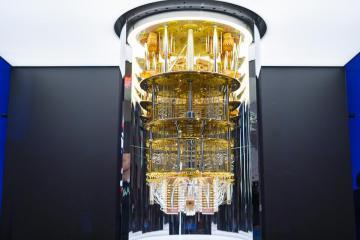
Achievement
A team of researchers from the Quantum Computing Institute at Oak Ridge National Laboratory (ORNL) and University of Tennessee investigated the stability of near-term intermediate scale quantum (NISQ) devices. The researchers characterized the reliability of these experimental computing devices by quantifying the essential criteria for a quantum computer to operate. They then studied the stability of state-of-the-art quantum computers to achieve those key metrics. The basis for their assessment was distribution similarity of the key metrics, evaluated in both time and space. For identical experiments, devices that produce reproducible histograms in time, and similar histograms in space, are considered more reliable. The researchers investigated the device reliability concerns of quantum computing community using data collected from IBM's Yorktown device. The paper won the IEEE Best Paper Award in the Quantum Benchmarking and Measurements tracks at the IEEE Quantum Computing Conference in October 2020.
Significance and Impact
Current quantum computer are facing a reproducibility crisis. A plethora of work in the field is published that is not replicable, and this raises serious questions on the long-term value of some quantum computing research tenets. The current work support quantifying the extent of reliability in quantum computers and guides industry and government agencies toward developing roadmaps that support more reliable NISQ devices and reproducible results.
Research Details
- Our contribution identified the stability of NISQ devices as a feature of fundamental importance to current testing and evaluation.
- We presented a framework to evaluate the stability of NISQ devices (using moment-based distance). We analyzed the stability of several different types of distributions that characterize the behavior of NISQ devices. These analyses can be extended to additional characteristics, including calibration date, optimal pulse data, and other features to develop insight into the device stability.
- We characterized a current QPU (Quantum Processing Unit) in terms of these metrics and then presented the characterization of stability in NISQ devices using a framework built on discriminating between the statistical processes that describe these empirical metrics.
- The premise of our approach is that the long-term reproducibility of results from experimental quantum computer science, and in particular those using NISQ devices, hinges on the stable and reliable performance of the computer device. Without additional efforts to make current experimental results reproducible across either time or other devices, the knowledge and insights gained from today's burgeoning field of quantum computer research may be undercut by low confidence in the reported results.
Citation and DOI:
S. Dasgupta and T. S. Humble, "Characterizing the Stability of NISQ Devices," 2020 IEEE International Conference on Quantum Computing and Engineering (QCE), Denver, CO, USA, 2020, pp. 419-429, doi: 10.1109/QCE49297.2020.00059.
Last Updated: March 11, 2021 - 1:50 pm